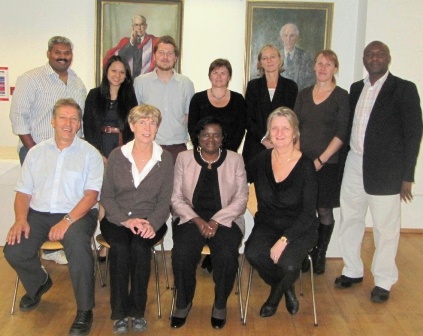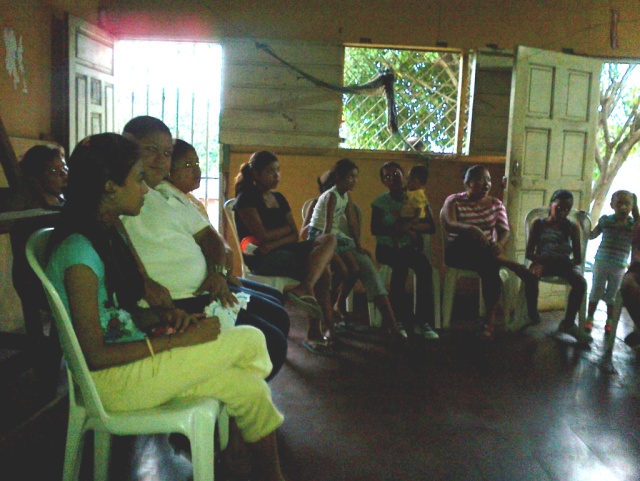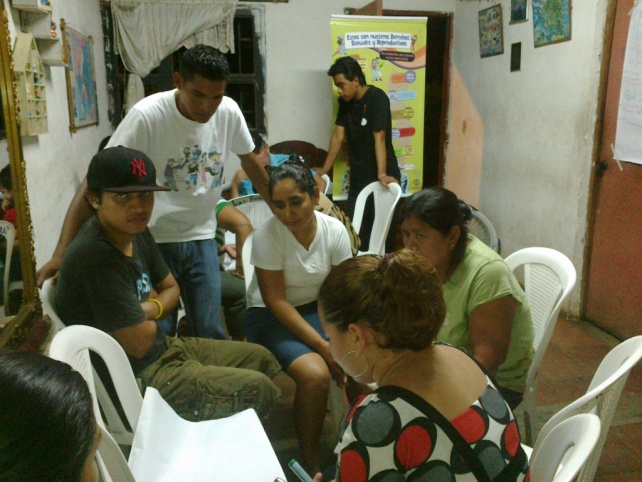Newsletter October 2012
ICRH Belgium Newsletter
16th of October, 2012
PROJECTS
MOMI's Scientific Advisory Board meeting
The Scientific Advisory Board of the MOMI project met for the first time on October 4 at UCL in London.
The Scientific Advisory Board of the MOMI project met for the first time on October 4 at UCL in London.
All board members work in an academic environment or are involved in research: Sophie Alexander as Director of the Perinatal Epidemiology and Reproductive Health Unit of the School of Public Health at the Université Libre de Bruxelles, Alexandre Dumont as Research Director at the Institut de Recherche pour le Développement in Dakar, Albrecht Jahn as Professor and leader of a research group on health systems and health policies in the Institute of Public health at the University of Heidelberg, Address Malata as Principal of the Kamuzu College of Nursing at the University of Malawi and Rosalind Raine as Professor of Health Care Evaluation at the University College London. The members discussed the progress of the MOMI project and gave guidance on future research directions, more specifically on the implementation and evaluation of the interventions which are planned to start soon in the four African partner countries (Burkina Faso, Kenya, Malawi and Mozambique). | |
 Note: Alexandre Dumont was absent due to cancellation of his early morning flight to London. | The members discussed the progress of the MOMI project and gave guidance on future research directions, more specifically on the implementation and evaluation of the interventions which are planned to start soon in the four African partner countries (Burkina Faso, Kenya, Malawi and Mozambique).Staff from three MOMI partners attended the meeting to present preliminary results of the policy review and situation analysis, to give an overview of the work performed so far and to inform about the future research plans: Els Duysburgh and Birgit Kerstens (ICRH), Sue Mann, Bejoy Nambiar and Tim Colbourn (UCL) and Charles Makwenda (PACHI). The meeting was presided by the "MOMI mommy", Marleen Temmerman, the overall consortium and project coordinator. More project news can be found on www.momiproject.eu |
CERCA field visits
In September Peter Decat (ICRH), Sara De Meyer (ICRH) and Lina Jaruseviciene (Kaunas university, Lithuania) who are responsible for coordination of the interventions carried out within the CERCA project, paid field visits to Ecuador and Nicaragua.
In both countries different intervention sites were visited: outreach work from primary health care providers in the communities, workshops with parents, video discussions with adolescents and health fairs.
|
Health Fair, Cuenca Ecuador |
|
Outreach work health care providers in the communities, Managua Nicaragua |
|
| Workshop with parents on contraceptives, Managua Nicaragua |
 |
| Video discussion with adolescents on sexuality communication and gender, Managua Nicaragua |
EVENTS
ICRH Team retreat 2012
The staff members of ICRH Belgium went on a two-days retreat to discuss strategy and internal organisation.
 On 29 September and 1 October, all staff members of ICRH Belgium who were available those days gathered in holiday resort ‘De Ceder’ in Astene near Ghent to exchange information and discuss the functioning and development perspectives of the organisation. The activity plans for the different ICRH topics for the next five years were presented, and the outline for a new organisational structure and a new team clustering was elaborated. In addition, many aspects of the functioning of ICRH were evaluated and improvement tracks were identified.
On 29 September and 1 October, all staff members of ICRH Belgium who were available those days gathered in holiday resort ‘De Ceder’ in Astene near Ghent to exchange information and discuss the functioning and development perspectives of the organisation. The activity plans for the different ICRH topics for the next five years were presented, and the outline for a new organisational structure and a new team clustering was elaborated. In addition, many aspects of the functioning of ICRH were evaluated and improvement tracks were identified.
The staff members of ICRH Belgium went on a two-days retreat to discuss strategy and internal organisation.
 On 29 September and 1 October, all staff members of ICRH Belgium who were available those days gathered in holiday resort ‘De Ceder’ in Astene near Ghent to exchange information and discuss the functioning and development perspectives of the organisation. The activity plans for the different ICRH topics for the next five years were presented, and the outline for a new organisational structure and a new team clustering was elaborated. In addition, many aspects of the functioning of ICRH were evaluated and improvement tracks were identified.
On 29 September and 1 October, all staff members of ICRH Belgium who were available those days gathered in holiday resort ‘De Ceder’ in Astene near Ghent to exchange information and discuss the functioning and development perspectives of the organisation. The activity plans for the different ICRH topics for the next five years were presented, and the outline for a new organisational structure and a new team clustering was elaborated. In addition, many aspects of the functioning of ICRH were evaluated and improvement tracks were identified.Mariela Castro visits ICRH
 Mariela Castro, director of the Cuban National Center for Sex Education in Havana and an activist for lesbian, gay, bisexual and transgender rights in Cuba visited Belgium and spent a day in Ghent.
Mariela Castro, director of the Cuban National Center for Sex Education in Havana and an activist for lesbian, gay, bisexual and transgender rights in Cuba visited Belgium and spent a day in Ghent.
As an advocate for LGBT rights, Mariela Castro lied at the basis of the 2008 law that allows transgendered people in Cuba to receive sex reassignment surgery and change their legal gender without charge. On 26 September she attended the launch of a new training program on sexology that is organized jointly by the faculty of Medicine and Health Sciences and the faculty of Psychology and Educational Sciences. In the afternoon she visited ICRH and we visited together an exhibition on youth and sexuality of our partner organisation Sensoa, the city hall of Ghent where she met the mayor, and the LGBT centre ‘Casa Rosa’ where she exchanged views with representatives of Cavaria, the federation of Flemish and Brussels LGBT organisations. In the coming months, we will explore possibilities to work together on projects.
 Mariela Castro, director of the Cuban National Center for Sex Education in Havana and an activist for lesbian, gay, bisexual and transgender rights in Cuba visited Belgium and spent a day in Ghent.
Mariela Castro, director of the Cuban National Center for Sex Education in Havana and an activist for lesbian, gay, bisexual and transgender rights in Cuba visited Belgium and spent a day in Ghent.As an advocate for LGBT rights, Mariela Castro lied at the basis of the 2008 law that allows transgendered people in Cuba to receive sex reassignment surgery and change their legal gender without charge. On 26 September she attended the launch of a new training program on sexology that is organized jointly by the faculty of Medicine and Health Sciences and the faculty of Psychology and Educational Sciences. In the afternoon she visited ICRH and we visited together an exhibition on youth and sexuality of our partner organisation Sensoa, the city hall of Ghent where she met the mayor, and the LGBT centre ‘Casa Rosa’ where she exchanged views with representatives of Cavaria, the federation of Flemish and Brussels LGBT organisations. In the coming months, we will explore possibilities to work together on projects.
Standards for sexuality education
Expert group discussed ‘Guidance for implementation’ for the WHO Standards for Sexuality Education.
 Many countries in the WHO European Region are familiar with the Standards for sexuality education: A framework for policy makers, educational and health authorities and specialists (2010). Several countries have already translated the Standards into national languages and used them to improve existing sexuality education systems, however, many questions have been raised on e.g. what is the best way to develop a new programme or how to review an existing one.
Many countries in the WHO European Region are familiar with the Standards for sexuality education: A framework for policy makers, educational and health authorities and specialists (2010). Several countries have already translated the Standards into national languages and used them to improve existing sexuality education systems, however, many questions have been raised on e.g. what is the best way to develop a new programme or how to review an existing one.
To answer these questions an expert group under the leadership of BZgA, the WHO Collaborating Centre for Sexual and Reproductive Health, has developed the “Guidance for implementation” that was discussed during the expert meeting 6–7 September in Cologne, Germany. ICRH was represented by Kristien Michielsen during the two-day meeting.
Lively debates resulted in the final draft of the Guidance. The launch of the document is planned for early 2013.
More information: Kristien.michielsen@ugent.be
Expert group discussed ‘Guidance for implementation’ for the WHO Standards for Sexuality Education.
 Many countries in the WHO European Region are familiar with the Standards for sexuality education: A framework for policy makers, educational and health authorities and specialists (2010). Several countries have already translated the Standards into national languages and used them to improve existing sexuality education systems, however, many questions have been raised on e.g. what is the best way to develop a new programme or how to review an existing one.
Many countries in the WHO European Region are familiar with the Standards for sexuality education: A framework for policy makers, educational and health authorities and specialists (2010). Several countries have already translated the Standards into national languages and used them to improve existing sexuality education systems, however, many questions have been raised on e.g. what is the best way to develop a new programme or how to review an existing one.To answer these questions an expert group under the leadership of BZgA, the WHO Collaborating Centre for Sexual and Reproductive Health, has developed the “Guidance for implementation” that was discussed during the expert meeting 6–7 September in Cologne, Germany. ICRH was represented by Kristien Michielsen during the two-day meeting.
Lively debates resulted in the final draft of the Guidance. The launch of the document is planned for early 2013.
More information: Kristien.michielsen@ugent.be
Lunch meeting on Pregnancy and Violence
On November 27th 2012 the Intercultural Women Network ‘Oog in Oog’ organizes a lunch meeting on ‘pregnancy and violence’.
An-Sofie Van Parys will present some research data and preliminary results of her PhD on ‘pregnancy and violence’ during a lunch meeting organized by the Intercultural Women Network ‘Oog in Oog’, of which ICRH is a member. An-Sofie works as PhD-fellow and researcher at ICRH. The lunch meeting will take place in ‘Het Vredeshuis’ in Ghent from 12.30 until 01.30 p.m.
More information: ansofie.vanparys@ugent.be
On November 27th 2012 the Intercultural Women Network ‘Oog in Oog’ organizes a lunch meeting on ‘pregnancy and violence’.
An-Sofie Van Parys will present some research data and preliminary results of her PhD on ‘pregnancy and violence’ during a lunch meeting organized by the Intercultural Women Network ‘Oog in Oog’, of which ICRH is a member. An-Sofie works as PhD-fellow and researcher at ICRH. The lunch meeting will take place in ‘Het Vredeshuis’ in Ghent from 12.30 until 01.30 p.m.
More information: ansofie.vanparys@ugent.be
ICRH PEOPLE
People leaving ICRH
Jessika Deblonde, Anke Van Vossole, Caroline Duprez and Joana Lima have left ICRH.
 Jessika, a master in law with a specialisation in public health, has been working for ICRH since 2002, mainly on research related to HIV testing and gender issues. In September, she started working at the Belgian Scientific Institute for Public Health (WIV-ISP).
Jessika, a master in law with a specialisation in public health, has been working for ICRH since 2002, mainly on research related to HIV testing and gender issues. In September, she started working at the Belgian Scientific Institute for Public Health (WIV-ISP).
Jessika Deblonde, Anke Van Vossole, Caroline Duprez and Joana Lima have left ICRH.
 Jessika, a master in law with a specialisation in public health, has been working for ICRH since 2002, mainly on research related to HIV testing and gender issues. In September, she started working at the Belgian Scientific Institute for Public Health (WIV-ISP).
Jessika, a master in law with a specialisation in public health, has been working for ICRH since 2002, mainly on research related to HIV testing and gender issues. In September, she started working at the Belgian Scientific Institute for Public Health (WIV-ISP). Anke, a master in social and cultural anthropology, joined ICRH in the beginning of 2010. She was involved in the organisation of the international training course ‘Coordination of Multi-Sectoral Response to Gender-Based Violence in Humanitarian Settings’ and she did research on harmful traditional practices.
Caroline worked part-time in ICRH administration during one year, after which she resumed her previous fulltime job at the University College Ghent.
Joana Lima joined ICRH within the context of an internship programme, and she worked mainly on international academic cooperation and research proposal development. In September she started working at the European Public Health Alliance as a policy officer.
Wei-Hong Zhang
ICRH senior researcher Dr. Wei-Hong Zhang was appointed from 1 October on as professor at the Université Libre de Bruxelles (ULB).
 Wei-Hong Zhang graduated in Medicine in China in 1987. She worked as a research and teaching assistant in anatomy and pathology in China before coming to live in Belgium in 1991. She gained two MPHs (one in French and another in English) in the School of Public Health, Université Libre de Bruxelles (ULB), Belgium in 1996-1997. Since 1998 she has been doing research into perinatal epidemiology in the Perinatal Epidemiology and Reproductive health Unit (PERU) at the ULB where she has been involved in several EU-funded collaborative projects in Europe in the field of reproductive health and where she obtained a PhD in Public Health in 2007. In April 2007, she joined the ICRH where she was responsible among others for EU-funded projects in China in the field of maternal health. At the ULB, Wei-Hong will be teaching epidemiology for master degree students. She will also remain connected part time to ICRH for the coordination of the EU funded INPAC project (INtegrating Post-Abortion family planning services into existing abortion services in hospital settings in China).
Wei-Hong Zhang graduated in Medicine in China in 1987. She worked as a research and teaching assistant in anatomy and pathology in China before coming to live in Belgium in 1991. She gained two MPHs (one in French and another in English) in the School of Public Health, Université Libre de Bruxelles (ULB), Belgium in 1996-1997. Since 1998 she has been doing research into perinatal epidemiology in the Perinatal Epidemiology and Reproductive health Unit (PERU) at the ULB where she has been involved in several EU-funded collaborative projects in Europe in the field of reproductive health and where she obtained a PhD in Public Health in 2007. In April 2007, she joined the ICRH where she was responsible among others for EU-funded projects in China in the field of maternal health. At the ULB, Wei-Hong will be teaching epidemiology for master degree students. She will also remain connected part time to ICRH for the coordination of the EU funded INPAC project (INtegrating Post-Abortion family planning services into existing abortion services in hospital settings in China).
More information: WeiHong.Zhang@UGent.be
ICRH senior researcher Dr. Wei-Hong Zhang was appointed from 1 October on as professor at the Université Libre de Bruxelles (ULB).
 Wei-Hong Zhang graduated in Medicine in China in 1987. She worked as a research and teaching assistant in anatomy and pathology in China before coming to live in Belgium in 1991. She gained two MPHs (one in French and another in English) in the School of Public Health, Université Libre de Bruxelles (ULB), Belgium in 1996-1997. Since 1998 she has been doing research into perinatal epidemiology in the Perinatal Epidemiology and Reproductive health Unit (PERU) at the ULB where she has been involved in several EU-funded collaborative projects in Europe in the field of reproductive health and where she obtained a PhD in Public Health in 2007. In April 2007, she joined the ICRH where she was responsible among others for EU-funded projects in China in the field of maternal health. At the ULB, Wei-Hong will be teaching epidemiology for master degree students. She will also remain connected part time to ICRH for the coordination of the EU funded INPAC project (INtegrating Post-Abortion family planning services into existing abortion services in hospital settings in China).
Wei-Hong Zhang graduated in Medicine in China in 1987. She worked as a research and teaching assistant in anatomy and pathology in China before coming to live in Belgium in 1991. She gained two MPHs (one in French and another in English) in the School of Public Health, Université Libre de Bruxelles (ULB), Belgium in 1996-1997. Since 1998 she has been doing research into perinatal epidemiology in the Perinatal Epidemiology and Reproductive health Unit (PERU) at the ULB where she has been involved in several EU-funded collaborative projects in Europe in the field of reproductive health and where she obtained a PhD in Public Health in 2007. In April 2007, she joined the ICRH where she was responsible among others for EU-funded projects in China in the field of maternal health. At the ULB, Wei-Hong will be teaching epidemiology for master degree students. She will also remain connected part time to ICRH for the coordination of the EU funded INPAC project (INtegrating Post-Abortion family planning services into existing abortion services in hospital settings in China).More information: WeiHong.Zhang@UGent.be
PUBLICATIONS
Estimating HIV incidence
A General HIV Incidence Inference Scheme Based on Likelihood of Individual Level Data and a Population Renewal Equation.
Accurate HIV incidence estimates are essential when monitoring the course of HIV epidemics and assessing the impact of HIV prevention interventions. However, obtaining precise, unbiased HIV incidence estimates is challenging and a field of active research. Multiple methods have been developed over recent years to estimate HIV incidence from HIV prevalence data. In many countries with generalised HIV epidemics, repeated national HIV prevalence surveys are already in place, making prevalence-based incidence estimation methods more feasibility and affordability than the empirical, cohort-based alternative.
This paper describes a new method to estimate the age specific incidence of an infection with differential mortality. The method is based on an SI-type model to express the incidence as a function of the prevalence, its derivatives and the excess mortality, in combination with a maximum likelihood estimation approach to estimate the prevalence and its derivatives from individual level infection status data from successive surveys. The authors show how earlier methods for estimating incidence from prevalence data can be derived from these general renewal equations by making additional assumptions, and how this has the potential to degrade accuracy and precision.
Numerical simulation of HIV epidemics, under the presumption of known excess mortality due to infection, shows improved control of bias and variance, compared to previous methods Our analysis motivates for a) effort to be applied to obtain accurate estimates of excess mortality rates as a function of age and time among HIV infected individuals and b) use of individual level rather than aggregated data in order to estimate the HIV incidence in the interval in-between two prevalence surveys.
Mahiane GS, Ouifki R, Brand H, Delva W, Welte A (2012) A General HIV Incidence Inference Scheme Based on Likelihood of Individual Level Data and a Population Renewal Equation. PLoS ONE 7(9): e44377.
http://www.plosone.org/article/info%3Adoi%2F10.1371%2Fjournal.pone.0044377
A General HIV Incidence Inference Scheme Based on Likelihood of Individual Level Data and a Population Renewal Equation.
Accurate HIV incidence estimates are essential when monitoring the course of HIV epidemics and assessing the impact of HIV prevention interventions. However, obtaining precise, unbiased HIV incidence estimates is challenging and a field of active research. Multiple methods have been developed over recent years to estimate HIV incidence from HIV prevalence data. In many countries with generalised HIV epidemics, repeated national HIV prevalence surveys are already in place, making prevalence-based incidence estimation methods more feasibility and affordability than the empirical, cohort-based alternative.
This paper describes a new method to estimate the age specific incidence of an infection with differential mortality. The method is based on an SI-type model to express the incidence as a function of the prevalence, its derivatives and the excess mortality, in combination with a maximum likelihood estimation approach to estimate the prevalence and its derivatives from individual level infection status data from successive surveys. The authors show how earlier methods for estimating incidence from prevalence data can be derived from these general renewal equations by making additional assumptions, and how this has the potential to degrade accuracy and precision.
Numerical simulation of HIV epidemics, under the presumption of known excess mortality due to infection, shows improved control of bias and variance, compared to previous methods Our analysis motivates for a) effort to be applied to obtain accurate estimates of excess mortality rates as a function of age and time among HIV infected individuals and b) use of individual level rather than aggregated data in order to estimate the HIV incidence in the interval in-between two prevalence surveys.
Mahiane GS, Ouifki R, Brand H, Delva W, Welte A (2012) A General HIV Incidence Inference Scheme Based on Likelihood of Individual Level Data and a Population Renewal Equation. PLoS ONE 7(9): e44377.
http://www.plosone.org/article/info%3Adoi%2F10.1371%2Fjournal.pone.0044377
Antiseptics and disinfectants for the treatment of bacterial vaginosis
A systematic review to assess and summarize the available data on efficacy and tolerability of antiseptics and disinfectants in treating bacterial vaginosis (BV).
The systematic search was conducted by consulting the PubMed (1966-2010), CINAHL (1982-2010), IPA (1970-2010), and the Cochrane CENTRAL databases. Clinical trials were searched for by including all generic names of antiseptics and disinfectants listed in the Anatomical Therapeutic Chemical (ATC) Classification System under the code D08A. Clinical trials were considered eligible if the efficacy of antiseptics and disinfectants in the treatment of BV was assessed in comparison to placebo or standard antibiotic treatment with metronidazole or clindamycin and if diagnosis of BV relied on standard criteria like Amsel's and Nugent's criteria.
A total of 262 articles were found, of which 15 reports on clinical trials were assessed. Of these, five RCTs were withheld. Reasons for non inclusion were primarily lack of use of standard criteria to diagnose BV or to assess cure and control treatment not involving placebo or standard antibiotic treatment. Risk of bias for the included studies was assessed with the Cochrane Collaboration's tool for assessing risk of bias. One study showed a trend towards a beneficial effect of benzydamine compared to placebo. Three other studies showed non-inferiority of chlorhexidine and polyhexamethylene biguanide compared to metronidazole or clindamycin. One RCT found that a single vaginal douche with hydrogen peroxide was slightly, though significantly less effective than a single oral dose of metronidazole.
The authors conclude that the use of antiseptics and disinfectants for the treatment of BV has been poorly studied and most studies are somehow methodologically flawed. Limited data indicate that some antiseptics may have equal efficacy in treating BV on short term compared to treatment with clindamycin or metronidazole. Further study is however warranted with special regard to long-term efficacy and safety of antiseptics and disinfectants for vaginal use.
Verstraelen H, Verhelst R, Roelens K, Temmerman M. Antiseptics and disinfectants for the treat-ment of bacterial vaginosis: a systematic review. BMC Infect Dis. 2012 Jun 28;12(1):148. http://www.ncbi.nlm.nih.gov/pmc/articles/PMC3458956/
HIV prevention in Rwanda
Results from a non-randomized controlled trial on effectiveness of a peer-led HIV prevention intervention in secondary schools in Rwanda.
While the HIV epidemic is levelling off in sub-Saharan Africa, it remains at an unacceptably high level. Young people aged 15-24 years remain particularly vulnerable, resulting in a regional HIV prevalence of 1.4% in young men and 3.3% in young women. This study assesses the effectiveness of a peer-led HIV prevention intervention in secondary schools in Rwanda on young people's sexual behavior, HIV knowledge and attitudes.
In a non-randomized longitudinal controlled trial, fourteen schools were selected in two neighboring districts: Bugesera (intervention) and Rwamagana (control). Students (n = 1950) in eight intervention and six control schools participated in three surveys (baseline, six and twelve months in the intervention). Analysis was done using linear and logistic regression using generalized estimation equations adjusted for propensity score.
The overall retention rate was 72%. Time trends in sexual risk behavior (being sexually active, sex in last six months, condom use at last sex) were not significantly different in students from intervention and control schools, nor was the intervention associated with increased knowledge, perceived severity or perceived susceptibility. It did significantly reduce reported stigma.
Analyzing this and other interventions, several reasons were identified for the observed limited effectiveness of peer education: 1) intervention activities (spreading information) are not tuned to objectives (changing behavior); 2) young people prefer receiving HIV information from other sources than peers; 3) outcome indicators are not adequate and the context of the relationship in which sex occurs. Effectiveness of peer education may increase through integration in holistic interventions and redefining peer educators' role as focal points for sensitization and referral to experts and services. Finally, the authors argue that a narrow focus on sexual risks will never significantly turn the tide.
Kristien Michielsen, Roxanne Beauclair, Wim Delva, Kristien Roelens, Ronan Van Rossem and Marleen Temmerman. Effectiveness of a peer-led HIV prevention intervention in secondary schools in Rwanda: results from a non-randomized controlled trial. BMC Public Health 2012, 12:729
Nothing as Practical as a Good Theory?
The Theoretical Basis of HIV Prevention Interventions for Young People in Sub-Saharan Africa: a Systematic Review.
This paper assesses the extent to which HIV prevention interventions for young people in sub-Saharan Africa are grounded in theory and if theory-based interventions are more effective. Three databases were searched for evaluation studies of HIV prevention interventions for youth. Additional articles were identified on websites of international organisations and through searching references. 34 interventions were included; 25 mentioned the use of theory. Social Cognitive Theory was most prominent (n = 13), followed by Health Belief Model (n = 7), and Theory of Reasoned Action/Planned Behaviour (n = 6). These cognitive behavioural theories assume that cognitions drive sexual behaviour. Reporting on choice and use of theory was low. Only three articles provided information about why a particular theory was selected. Interventions used theory to inform content (n = 13), for evaluation purposes (n = 4) or both (n = 7). No patterns of differential effectiveness could be detected between studies using and not using theory, or according to whether a theory informed content, and/or evaluation. The authors discuss characteristics of the theories that might account for the limited effectiveness observed, including overreliance on cognitions that likely vary according to type of sexual behaviour and other personal factors, inadequately address interpersonal factors, and failure to account for contextual factors.
Kristien Michielsen, Matthew Chersich, Marleen Temmerman, Tessa Dooms and Ronan Van Rossem. Nothing as Practical as a Good Theory? The Theoretical Basis of HIV Prevention Interventions for Young People in Sub-Saharan Africa: A Systematic Review. AIDS Res Treat. 2012;2012:345327. Epub 2012.
Sexual coercion among in-school adolescents in Rwanda
Prevalence and correlates of victimization and normative acceptance.
Adolescents are particularly vulnerable to sexual coercion, as victim as well as perpetrator. This paper aims to adapt sexual and reproductive health interventions to the reality of young people’s sexuality and relationships. This study assesses the prevalence of forced sex, characteristics of victims and norms regarding sexual coercion among Rwandan adolescents. A survey was completed by 285 senior secondary school students and four focus groups were conducted. Of sexually active respondents, 15.5% (95% CI = [15.1 – 15.9]) reported forced sexual intercourse. Sexual victimization was associated with being female and having (had) a concurrent sexual relationship. Acceptance of sexual coercion was associated with importance attached to Rwandan traditions and an interaction term between sex (being male) and alcohol use. Respondents linked concurrency and age-disparate relationships to transactional sex, increasing the risk of sexual coercion. Various risk factors were identified. The findings suggest the need for moving towards comprehensive sex education.
Els Van Decraen, Kristien Michielsen, Sarah Herbots, Ronan Van Rossem, Marleen Temmerman. Sexual coercion among in-school adolescents in Rwanda: prevalence and correlates of victimization and normative acceptance. Afr J Reprod Health 2012; 16[3]: 139-153
Challenges with using estimates when calculating ART need among adults in South Africa
The Foundation for Professional Development (FPD) collects information annually on HIV/AIDS service provision and estimates service needs in the City of Tshwane Metropolitan Municipality (CTMM).
Antiretroviral therapy (ART) data from the Department of Health and Statistics South Africa (SSA) mid-year population estimates were used to approximate the ART need among adults in the CTMM.
According to SSA data, ART need decreased dramatically from 2010 to 2011 and was lower than the number of adults receiving ART. Although the noted difference was probably due to changes in the calculations by SSA, no detailed or confirmed explanation could be offered.
The authors conclude by providing a constructive contribution to the discussion regarding the use of model-derived estimates of ART need.
Gerritsen AAM, Michell JS, Johnson SM, Delva W. Challenges with using estimates when calculating ART need among adults in South Africa. S Afr Med J. 2012;102(10):798-799. DOI:10.7196/SAMJ.5946
Longitudinal study of the dynamics of L. crispatus, L. iners, A. vaginae, G. vaginalis, and P. bivia in the vagina
To obtain more detailed understanding of the causes of disturbance of the vaginal microflora (VMF), a longitudinal study was carried out for 17 women during two menstrual cycles.
Vaginal swabs were obtained daily from 17 non-pregnant, menarchal volunteers. For each woman, Gram stains were scored, the quantitative changes of 5 key vaginal species, i.e. Atopobium vaginae, Lactobacillus crispatus, L. iners, (sialidase positive) Gardnerella vaginalis and Prevotella bivia were quantified with qPCR and hydrogen-peroxide production was assessed on TMB+ agar.
Women could be divided in 9 subjects with predominantly normal VMF (grades Ia, Ib and Iab, group N) and 8 with predominantly disturbed VMF (grades I-like, II, III and IV, group D). VMF was variable between women, but overall stable for most of the women. Menses were the strongest disturbing factor of the VMF. L
This qPCR-based study confirms largely the results of previous culture-based, microscopy-based and pyrosequencing-based studies.
Guido Lopes dos Santos Santiago, Inge Tency, Hans Verstraelen, Rita Verhelst, Marijke Trog, Marleen Temmerman, Leen Vancoillie, Ellen Decat, Piet Cools, Mario Vaneechoutte. Longitudinal qPCR Study of the Dynamics of L. crispatus, L. iners, A. vaginae, (Sialidase Positive) G. vaginalis, and P. bivia in the Vagina. PLoS One. 2012;7(9):e45281. doi: 10.1371/journal.pone.0045281. Epub 2012 Sep 21.
‘That Pregnancy Can Bring Noise into the Family’
Exploring Intimate Partner Sexual Violence during Pregnancy in the Context of HIV in Zimbabwe.
Globally, studies report a high prevalence of intimate partner sexual violence (IPSV) and an associa-tion with HIV infection. Despite the criminalisation of IPSV and deliberate sexual HIV infection in Zimbabwe, IPSV remains common. This study explored women's and health workers' perspectives and experiences of sexuality and sexual violence in pregnancy, including in relation to HIV testing.
This qualitative study was part of a larger study of the dynamics of intimate partner violence and HIV in pregnancy in Zimbabwe. Key informant interviews were conducted with health workers and focus group discussions were held with 64 pregnant or nursing mothers attending antenatal and postnatal care clinics in low-income neighbourhoods of Harare, covering the major thematic areas of validated sexual violence research instruments. Thematic content analysis of audio-recorded and transcribed data was conducted.
While women reported some positive experiences of sex in pregnancy, most participants commonly experienced coercive sexual practices. They reported that men failed to understand, or refused to accept, pregnancy and its associated emotional changes, and often forced painful and degrading sexual acts on them, usually while the men were under the influence of alcohol or illicit drugs. Men often refused or delayed HIV testing, and participants reported accounts of HIV-positive men not disclosing their status to their partners and deliberately infecting or attempting to infect them. Women's passive acceptance of sexual violence was influenced by advice they received from other females to subordinate to their partners and to not deprive men of their conjugal sexual rights.
The authors conclude that cultural and societal factors, unequal gender norms and practices, wom-en's economic vulnerability, and men's failure to understand pregnancy and emotional changes, influence men to perpetrate IPSV, leading to high risk of HIV infection.
Shamu S, Abrahams N, Temmerman M, Shefer T, Zarowsky C. ‘That Pregnancy Can Bring Noise into the Family’: Exploring Intimate Partner Sexual Violence during Pregnancy in the Context of HIV in Zimbabwe. PLoS One. 2012;7(8):e43148. Epub 2012 Aug 24.
Pregnancy outcome of Moroccan and Turkish women in Belgium
This study compares perinatal outcome in women from Turkish and Moroccan descent versus au-tochthonous women in Belgium.
Methods applied were retrospective cohort study, data from an existing database, coupled with sociodemographic data from birth certificates.
There were more teenage pregnancies in the Moroccan and Turkish group, Moroccan women delivered more frequently after age 40 but Turkish women less frequently. In Moroccan and Turkish women the level of education was lower, they had less hypertension, fewer pregnancies after artificial reproductive technology and preterm deliveries, more diabetes and more grand multiparity. Moroccan women demonstrated more HIV infection. Planned cesarean section was less frequent in the Moroccan and Turkish group, and there was no difference for secondary cesarean section. Belgian women had more induction of labor, instrumental vaginal delivery and epidural anesthesia. There were more babies with low birth weight in both the Moroccan and Turkish group. Moroccan woman had more babies with a birth weight above 4500 g. Total perinatal death rate was higher for Moroccan women while there was no difference between Belgian and Turkish babies.
Jacquemyn Y, Benjahia N, Martens G, Yüksel H, Van Egmond K, Temmerman M. Pregnancy outcome of Moroccan and Turkish women in Belgium.' Clin Exp Obstet Gynecol. 2012;39(2):181-5.




